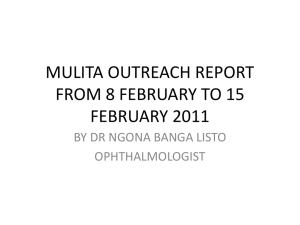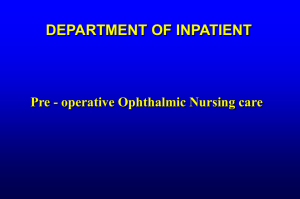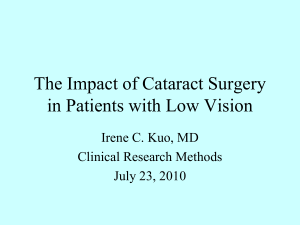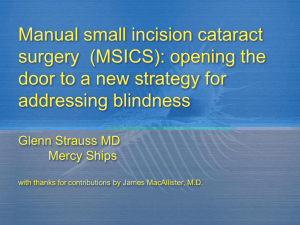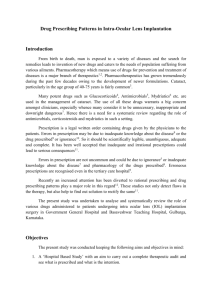iv. operative techniques in pediatric cataract surgery without iol
advertisement
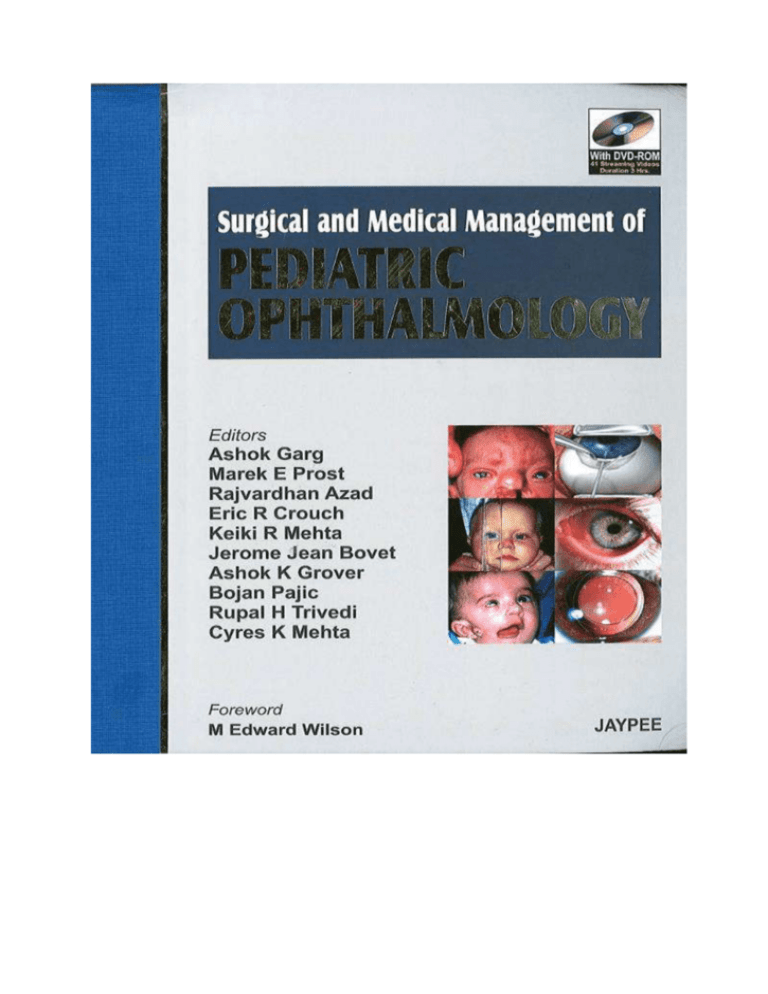
Cataract is one of the main causes of blindness or severe impairment of vision in children and the major preventable cause. According to Gilbert et al., who evaluated etiologies of children blindness in 40 countries, cataract is responsible for 12 % of blindness.(1) In Poland this disease caused blindness and visual impairment in 14% of children in years 1979- 1999 (2) although in recent years its importance as the cause of blindness is decreasing (3). In children younger than 7 years cataract does not merely decrease visual acuity but it also disrupts the development of visual system in the CNS. The aim of the cataract surgery in children is to create the best conditions for the development of binocular vision. Good visual acuity after the surgery is final result in senile cataract treatment but not in children. Therefore, contrary to the established standards of cataract surgery in adults, management of pediatric cataract remains, even nowadays, very complex and is associated with different challenges: problem of IOL use, IOL power calculations, technical problems during surgery, postoperative complications and many problems connected with visual training after the surgery (compliance, irreversible functional changes of amblyopia, development of binocular vision etc). The aim of this chapter is to discuss the details of the surgery technique which are the most important in the development of binocular vision in children after cataract surgery basing on the authors experience. For the development of binocular vision in children it is necessary to maintain: I. Good visual acuity in both eyes A. Clear optical media B. Focused retinal image in all periods of visual development (small refractive error, possibility of optical correction adaptation) C. No abnormalities of retina and optic nerve D. Normal development of subcortical and cortical visual system II. Comparable vision in both eyes III. Proper eye alignment IV. Possibility of normal visual functioning through the whole period of visual development. Not all of these factors are under our control. But we should to adopt our indications for surgery, surgical technique and postoperative care to create the best conditions for binocular development. I. TIMING OF SURGERY There are some publications that surgical intervention in children smaller than 6 weeks can diminish the effects of visual deprivation on the development of visual system. (4) There are suggestions that the critical period for binocular development begins at age of five to six weeks of age. (5, 6) Earlier surgery means also earlier possibility of amblyopia treatment and the better chance to overcome functional visual deficit. So, if there is lens opacification which can interfere with the development of binocular vision the surgery should be performed in infants younger than 6 weeks. However, it have been found that secondary glaucoma is occurring more frequently in children with congenital cataract operated before 1 month of age. (7, 8) The risk of anesthesia is also higher in children younger than 1 month. Operation performed in very small, soft eye (as in children of some days of age) is also technically more difficult. Therefore it seems that the most reasonable period for cataract surgery in small children is 4-6 weeks of age. II. PRIMARY IOL IMPLANTATION IN CHILDREN YOUNGER THAN 1 YEAR First IOL implantation in a child was performed probably by Epstein in 1952. This patient still has 20/20 best corrected visual acuity after forty-six years. (9) In adults IOL implantation is now standard procedure in cataract surgery. However, in children there are still controversies about the most appropriate age for IOL implantation at the time of cataract surgery in children. Growing pediatric eye still present many challenges not to be encountered in adult patients. Most of pediatric cataract surgeons implant now IOLs in children older than 1-2 years of age. (10, 11, 13) In unilateral cataract generally IOLs are implanted even in earlier age because of contact lens noncompliance in some of the operated children. As surgical techniques and IOL design improve constantly the trend is toward earlier IOL implantation in children. Main problems with primary IOL implantation in children younger than 1 year are poor predictability of IOL power, lack of pediatric-size of IOLs, more frequent postoperative complications (high rate of visual axis opacification), enhanced inflammatory responses and technical difficulties with the surgery in these children and no data on the long term safety of IOLs. (11) Therefore, most of cataract surgeons and pediatric ophthalmologists do not advise IOL implantation in the first year of life although the recommendations and preferences of various surgeons are constantly evolving. (10, 11, 13) May be the answer will give us Infants Aphakia Treatment Study, multicenter clinical trial funded by National Eye Institute in USA which is now under way. (12) Author’s current strategy is to implant IOLs in children older than 1 year. In younger patients implantation is performed when there are strong suspicions of future contact lens noncompliance. Parents of these patients should be informed that most probably secondary operation (visual axis opacification) will be necessary. III. PREOPERATIVE EVALUATION Parents of the child with cataract should be asked for family history of cataract. It is also advisable to perform slit lamp examination of both parents and siblings to determine any hereditary lens abnormalities. If possible laboratory tests for metabolic (galactose or galactose converting enzyme levels, blood sugar, aminoacids in urine, plasma calcium and phosphorus levels, urine-reducing substances after milk feeding) or infectious (TORCH) diseases should be performed. (13) Ophthalmic evaluation should include slit lamp and fundus examinations, IOP measurement, A- and B-scan ultrasonography (to measure axial length and examine any posterior segment abnormalities) and keratometry. In small children the examination of both anterior and posterior segments can be performed with indirect ophthalmoscope or hand-held slit lamp. Very useful for children examination is also hand-held keratometer. IV. OPERATIVE TECHNIQUES IN PEDIATRIC CATARACT SURGERY WITHOUT IOL IMPLANTATION Historical techniques as discission and aspiration-irrigation with double-barreled cannula are no more used nowadays. The preferred method of operation in pediatric cataract surgery is now lensectomy with anterior vitrectomy with the use of vitrectomy machines. Two main surgical approaches are used: pars plana and limbal. (11, 13) Both techniques have their advantages and disadvantages (table I). Author preferred technique is pars plana approach because surgical trauma to the iris and cornea (endothelium) is minimized and anterior segment of the eye is practically intact during surgery. It is of great advantage in children eyes because shallow anterior chamber, laxity of iris tissue and high elasticity of the cornea cause that with limbal approach these eyes are more prone to development of anterior iris synechias, iris damage and postoperative pupillary anomalies. In both techniques after eye opening capsulotomy is first performed with vitrectomy probe (anterior vitrectorhexis in limbal approach and posterior capsulotomy in pars plana approach) followed by removal of lens nucleus and cortical material (usually by aspiration or by cutting as necessary), posterior (limbal approach) or anterior (pars plana approach) and anterior vitrectomy. (Fig. 1, video) In both of these techniques peripheral parts of both anterior and posterior capsules are left. (Fig. 2) They are used in the future as scaffold for IOL implantation. IOL could be implanted in the sulcus or in the bag (if it is possible to reopen the bag during implantation, which may be difficult but is possible). Sutureless pars plana vitrectomy through the self-sealing sclerotomies and conjunctival wound has been recently reported. (14) Pediatric cataract surgery without IOL implantation is usually performed in children younger than 1 year. Problem of IOL implantation in this group of age is still controversial and we do not know the definitive answer yet. (see above) Table I ADVANTAGES AND DISADVANTAGES OF PARS PLANA AND LIMBAL APPROACH FOR LENSECTOMY WITH ANTERIOR VITRECTOMY PRIMARY PEDIATRIC CATARACT SURGERY Approach Pars plana Advantages and disadvantages Limbal IN 1. Less trauma to iris and cornea 2. Less postoperative iris synechias and pupillary deformations Advantages 3. Better access to changes behind the iris 4. Possibility of combined posterior vitrectomy 1. Lack of the conjunctival wound 2. Limbal approach is more familiar to the pediatric anterior segment surgeons 5. No problems with anterior chamber shallowing during surgery 1. More trauma to iris and cornea 2. Greater risk of iris damage 3. More postoperative iris Disadvantages 1. Pars plana approach is less synechias and pupillary familiar to the pediatric deformations anterior segment surgeons 4. Sometimes more difficult access to changes behind the iris 5. No possibility of combined posterior vitrectomy 2–3 mm Fig, 1 Schematic presentation of technique of lensectomy with anterior vitrectomy in primary pediatric cataract surgery without IOL implantation 4 - 5 mm 2-3 mm Fig.2 Schematic presentation of end result of lensectomy with anterior vitrectomy in primary pediatric cataract surgery without IOL implantation

